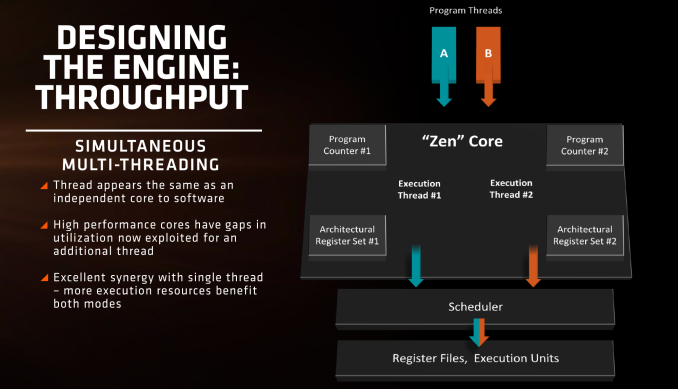AMD Zen Microarchitecture: Dual Schedulers, Micro-Op Cache and Memory Hierarchy Revealed
by Ian Cutress on August 18, 2016 9:00 AM ESTSimultaneous Multi-Threading
On Zen, each core will be able to support two threads in what is called ‘simulatenous multi-threading’. Intel has supported their version of SMT for a number of years, and other CPU manufacturers like IBM support up to 8 threads per core on their POWER8 platform designs. Building a core to be able to use multiple threads can be tough, as it requires a lot of resources to make sure that the threads do not block each other by consuming all the cache and buffers in play. But AMD will equip Zen with SMT which means we will see 8C/16T parts hitting the market.
Unlike Bulldozer, where having a shared FP unit between two threads was an issue for floating point performance, Zen’s design is more akin to Intel’s in that each thread will appear as an independent core and there is not that resource limitation that BD had. With sufficient resources, SMT will allow the core instructions per clock to improve, however it will be interesting to see what workloads will benefit and which ones will not.
Timeframe and Availability
At the presentation, it was given that Zen will be available in volume in 2017. As the AM4 platform will share a socket with Bristol Ridge, users are likely to see Bristol Ridge systems from AMD’s main OEM partners, like Dell and others, enter the market before separate Zen CPUs will hit the market for DIY builders. It’s a matter of principle that almost no consumer focused semiconductor company releases a product for the sale season, and Q1 features such events as CES, which gives a pretty clear indication of when we can expect to get our hands on one.
It’s worth noting that AMD said that as we get closer to launch, further details will come as well as deeper information about the design. It was also mentioned that the marketing strategy is also currently being determined, such that Zen may not actually be the retail product name for the line of processors (we already have Summit Ridge as the platform codename, but that could change for retail as well).
Wrap Up
AMD has gone much further into their core design than I expected this week. When we were told we had a briefing, and there were 200-odd press and analysts in the room, I was expecting to hear some high level puff about the brand and a reiteration of their commitment to the high end. To actually get some slides detailing parts of the microarchitecture, even at a basic cache level, was quite surprising and it somewhat means that AMD might have stolen the show with the news this week.
We’ve got another couple of pieces detailing some of the AMD internal/live benchmark numbers during the presentation, as well as the dual socket server platform, the 32-core Naples server CPU, and what we saw at the event in terms of motherboard design.











216 Comments
View All Comments
JoeyJoJo123 - Thursday, August 18, 2016 - link
The ignorance... It hurts...Original x86 (32-bit) was Intel-AMD developed.
AMD then developed x86-64, or x86 64-bit, and then Intel continues to license it to this day.
There's no copying here. Someone did it first, then others are licensing that IP from them.
See: https://en.wikipedia.org/wiki/X86-64
>x86-64 (also known as x64, x86_64 and AMD64) is the 64-bit version of the x86 instruction set.
>The original specification, created by AMD and released in 2000, has been implemented by AMD, Intel and VIA.
That's why sometimes you might see driver versions labeled AMD64, and you might be puzzled as to why despite being on a Intel 64-bit CPU that the 64-bit driver you downloaded states AMD64 in the name. It's because it was an AMD-first technology, but it's usable on any x86-64bit processor.
Bateluer - Thursday, August 18, 2016 - link
Intel simply paid for the license to copy the technology AMD designed. They still copied it, just legally paid for the right to do so.Klimax - Saturday, August 20, 2016 - link
Actually, not exactly correct. Intel was forced by Microsoft to adopt AMD's solution, despite Intel having parallel own implementation which was different. And Intel's version is still bit different from AMD's. (Some instructions are different between implementations, mostly relevant only to OS)xenol - Thursday, August 18, 2016 - link
IBM made the dual-core on a single die design.ExarKun333 - Thursday, August 18, 2016 - link
In many ways, Intel's 64-bit was superior to AMD's, but x86-64 was more backward compatible. I can see it both ways....different solutions to the same problem. Both companies have pushed each other...TheMightyRat - Thursday, August 18, 2016 - link
How is IA64 superior to AMD64?AMD64 can run 32-bit software without performance hit and still run 64-bit software comparatively equally to Intel counterpart.
IA64 Itanium runs 64-bit software much slower than a Pentium 4 64-bit at the same clock and has a massive performance hit in 32-bit emulation (1/3 as fast). Aren't both of them based on Netburst?
EMT64 only has more codes than AMD64 as it also implement both AMD64 and IA64, which is no longer used in modern server software anymore.
Klimax - Saturday, August 20, 2016 - link
He was talking about Intel's x64 which was backup plan in case Itanium fails.Myrandex - Thursday, August 25, 2016 - link
I don't think Itaniums were Netburst in architecture, it seemed to be a totally different architecture.Gigaplex - Thursday, August 18, 2016 - link
Itanium was novel but turned out to be a poor performer. It relied too much on good compilers optimising the instruction order.KPOM - Friday, August 19, 2016 - link
Wasn't Itanium based on "Very Long Instruction Word" architecture? Hence the long pipelines and reliance on clock speed? The Pentium M from Intel Israel righted Intel's ship and allowed them to take leadership of the x86 architecture back from AMD.